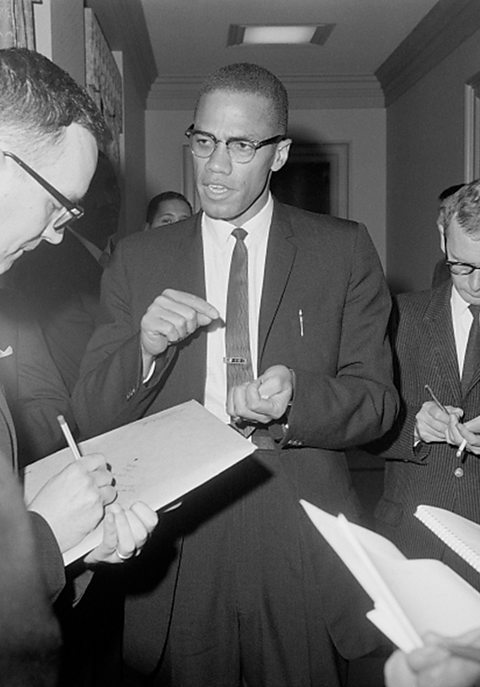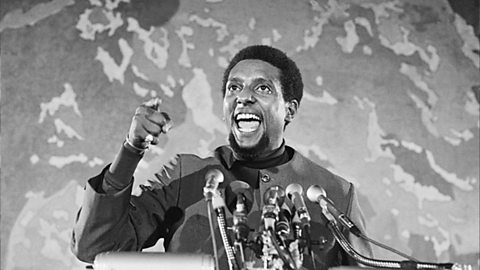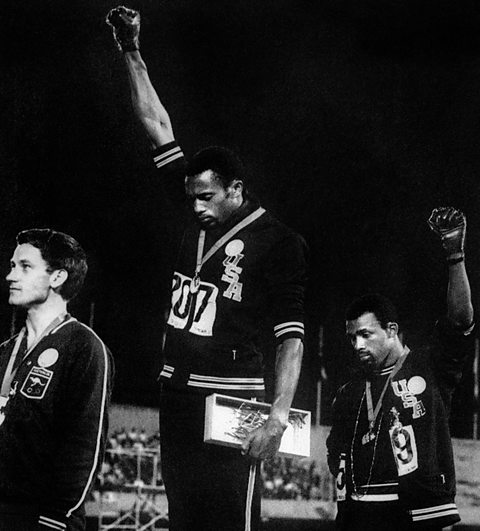The Black Power movement
Black Power was a political, social and cultural movement. Its advocates belief in black pride, self-sufficiency and freedom. Black Power was another expression of the overall African American struggle for freedom.
Through animation and archive footage explore civil rights and the origins of Black Power.
Malcolm X

The principles of Black Power were inspired by Malcolm X, who was originally a minister in the Nation of Islam, a black separatismThe desire to set up a separate nation for black people. Muslim organisation. He changed his name from Malcolm Little to Malcolm X to acknowledge that, as an African American, his real name and the identity of his ancestors had been erased when they were enslaved.
Malcolm X initially disagreed with Dr Martin Luther King Jnr and the other advocates of non-violence. In contrast, he believed in armed-self-defence.
Malcolm X was a powerful public speaker. His speeches boldly confronted segregationThis meant that white people and black people had to live separately. The areas of society affected by segregation included churches, hospitals, theatres and schools. and the legacy of racism and injustice. He also urged African Americans to take pride in their identity.
In March 1964, Malcolm X left the Nation of Islam. Shortly after, he created the Organization of Afro-American Unity. He was assassinateMurder for religious or political reasons. in 1965. However, his ideas and legacy continued.
The popularisation of Black Power

The civil rights movement had achieved a set of new civil rights laws, and these marked significant progress towards equality. However, these rights had not altered the economic status of most African Americans. The unemployment rate among black Americans was twice the national average. Poverty and powerlessness remained. Frustration developed at the continuing economic gap between black and white Americans and the persistence of racism.
In 1966, Student Nonviolent Coordinating Committee SNCCStudent Nonviolent Coordinating Committee initially promoted non-violent protest. leader Stokely Carmichael popularised the phrase тBlack Powerт during a speech in Mississippi. Carmichael had initially supported the philosophy and methods of non-violent protest. However, he became disillusionment A feeling of disappointment resulting from the discovery that something is not as good as one believed it to be. after experiencing peaceful protestors being attacked by violent racists.
Carmichael demanded a change in the language and strategy of the movement. Black Power was both a slogan and a way of thinking. Its supporters believed that:
- black people should work together in solidarity in order to benefit from living in a multiracial society
- black people needed to have more autonomyHaving control and the ability to make decisions. safety and economic power in their own communities
- black people should be proud of their heritage

Black Power received support from some high-profile African Americans.
- The boxer Muhammed Ali became a famous campaigner, especially after he refused to be drafted into the military during the Vietnam WarA war between communist North Vietnam and non-communist South Vietnam for control of the whole of Vietnam; the USA sent American troops to protect South Vietnam.
- At the 1968 Summer Olympics, Tommie Smith and John Carlos gave the Black Power salute at the 200-metre victory ceremony.
- The gesture was televised and seen by millions around the world.
The Black Panther Party for Self-Defense
The Black Panther Party for Self-Defense was founded by Huey Newton and Bobby Seale in 1966 when they published their Ten-Point Plan manifestoA written statement that describes the policies and opinions of a political party or candidate. The Black PanthersТ believed that non-violent protest would not fully give freedom or self-determinationThe right of the individual to determine what happens to them. to African Americans. They wanted universal employment, good housing, and better schools and education in black communities. They also addressed safety and police brutality by using their constitutional right to openly carry a weapon and defend themselves and their communities against attacks and violence.
Like Dr King and many civil rights activists, the Black Panthers became targets of J Edgar Hoover, the director of the Federal Bureau of Investigation (FBI)The domestic intelligence and security service of the United States, as well as acting as its main federal law enforcement agency. The FBI set up a counterintelligence programme called COINTELPRO. Techniques such as spying and wiretappingSecretly monitoring other peopleтs phone calls. were used against them. Unsubstantiated criminal charges were also raised against them.
The assassination of Dr King
- Economic and social injustice became more of a focus of Dr Kingтs work.
- He was also outspoken in his criticism of American involvement and policies in the Vietnam War.
- In April 1968, Dr King visited Memphis, Tennessee, to support black sanitation workers who were striking for equal treatment with white workers.
- On 4 April, he was assassinated while he stood on the balcony of his hotel room.
- James Earl Ray, a white racist, was arrested and imprisoned for his murder.